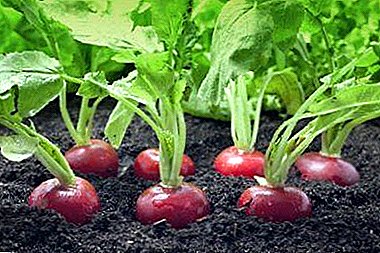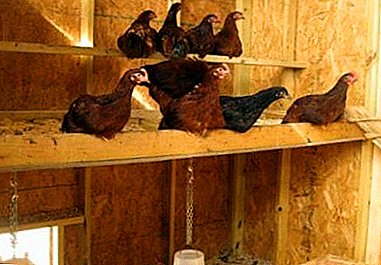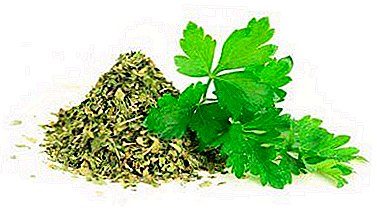
Radish is a very useful vegetable that can be grown almost all year round. Experienced gardeners get a good harvest by growing root vegetables in greenhouses.
This does not require special skills, but at any time of the year will allow you to get vitamins. In vitamins, this vegetable is rich, as is radish grown in the open field.
The distinctive features of the growth of radish in the greenhouse, as well as how exactly to grow this useful vegetable in such conditions will be described in the article.
The difference in terms of growth in open and closed ground
Currently presented a huge number of varieties of radish. All of them differ from each other in speed of ripening, taste. The peculiarity of growing vegetables in a greenhouse is that it grows a little slower than in open ground. Given this, many gardeners prefer to sow the earliest varieties.
What factors affect the growth of the root in the ground?
The growth rate and ripening of radish are such that they allow you to harvest a vegetable four times per season. Of course, an important role in this enterprise is played by the conditions in which the root vegetable is grown.
So, in a heated or heated greenhouse the plant will feel much better, due to this, its growth and maturation will accelerate. Sowing seeds in a cold ground in an unheated greenhouse will cause the vegetable to grow very slowly and fruits will form for a long time.
Experienced gardeners prefer to grow radish in polycarbonate greenhouses. In conditions of high humidity and the required temperature shoots appear on the third day.
The second most important when growing radish is its variety. There are early-ripening, mid-ripening and late varieties.. Early include:
 Heat;
Heat;- French breakfast;
- Early red;
- Camelot;
- Ruby;
- Hothouse.
To mid-season:
- Vikhovsky white;
- Mokhovsky;
- Red giant.
Late varieties:
- Dugan;
- Zenith.
The time of sowing also influences how quickly the radish can produce a crop. The growth rate of the fruit is also related to the time of year. In winter, the growth of radish will be slower than in spring. The difference in the ripening of vegetables in different periods is from 5 to 7 days.
What day does the vegetable go up?
Having set out to grow a winter crop of radish in your greenhouse, you need to remember that the seeds will grow only 6 - 8 days after sowing. For this you need to strictly observe all the rules of cultivation:
- maintain the necessary humidity;
- temperature;
- day length
Radish is a vegetable of short daylight. With prolonged illumination, unnecessary formation of arrows may occur.
The seeds of the radish of autumn sowing sprout in the same time as the winter, that is, 6 to 8 days after landing.
If we talk about seeds that were sown in spring or in summer, they germinate a little faster, and the first shoots will appear in 5-6 days.
When does a root crop ripen?
The greater the mass of the root, the faster it matures.
Terms of ripening radish depend on the variety. But on average, it was found that in the winter and autumn period in greenhouse conditions it will not be possible to grow a vegetable in 3-4 weeks, as promised by the manufacturer of early ripening varieties. At this time of year, fruits ripen more slowly - about 5 - 6 weeks.
Spring and summer harvest will gather much faster. Despite the fact that in the greenhouse conditions the radish grows a little slower, early ripening varieties can be used as food after 4 weeks.
Is it possible to speed up the ripening process?
 Directly accelerate the ripening process will not succeed. You can only contribute to good growth and, consequently, accelerated fruit ripening.
Directly accelerate the ripening process will not succeed. You can only contribute to good growth and, consequently, accelerated fruit ripening.
In order to get the desired roots as early as possible, experienced gardeners advise:
- Planted in the ground prepared, that is, germinated seeds.
- Landing for planting should be loose. This also affects the rate of ripening, as the fruits must breathe.
- When growing, you can use mineral fertilizers, which are abundantly presented on store shelves.
- Fertilizing should not be done in large quantities, because you can cause an intensive growth of green mass, which adversely affect the condition of the fetus.
Important. When growing radish, it is not recommended to use manure and nitrogen-containing fertilizers, as they slow down plant growth.
- The rate of ripening is affected by lighting. Although the radish grows better and forms with a short daylight, the lighting, albeit in a short period of time, should be good.
In order to grow a good crop in the greenhouse, it is necessary to follow all the rules of radish cultivation. It is better to use a heated greenhouse, which can be ventilated if necessary. Sowing to produce in prepared loose nutrient soil.
It is very important to produce timely watering., because juicy radish roots cannot fully form without a sufficient amount of moisture.
So, with a little knowledge and effort, you can have fresh, healthy vegetables grown on your own table all year round.


 Heat;
Heat;









